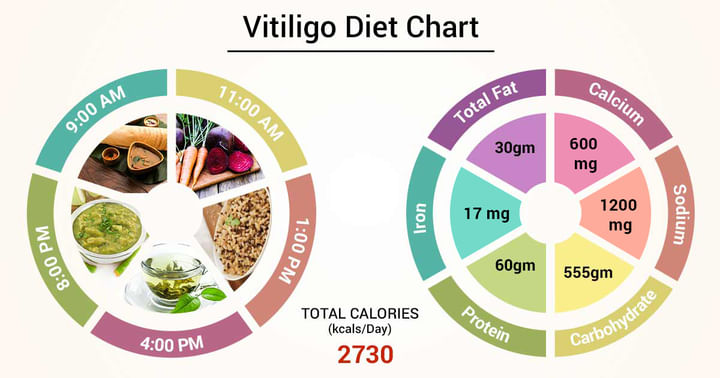Diet Chart For vitiligo
Last Updated: Jan 20, 2025
About
Vitiligo is a skin disease which happens to a normal human body. People who have this disease the colour of the skin changes from the normal colour of the body. There will be two types of colour in the body people with Vitiligo. Consulting a skin doctor and having proper vitiligo diet may cure this disease. It takes a long time to cure therefore people need an immense patience to get cured fully. There are certain food items that can be taken to cure the disease and there are some kinds of food items that should be avoided.
Food items that can be included in vitiligo diet are:
- Antioxidant - this includes enough amount of fruits and vegetables so that it keeps you fresh and active and prevent you from any allergy. It also helps the body to free radicals.
- Vegetables – need to take fresh green vegetables which includes French beans, radish, carrots, Spinach, Drumsticks etc.
- Fruits – it includes Mango, grape, walnut, dates etc.
- Other food items includes wheat, pure ghee, Almond, potatoes etc.
The food items that can be avoided are:
- Orange, custard apple, guava, cashew nut, brinjal, Papaya, tomato, garlic. There are some milk products which should be avoided are milk itself, curd and buttermilk.
Non-vegetarian foods which can be avoided are:
- Fish, red meat etc. Along with these food items the junk food also should be avoided so that the disease get cured soon.
Diet Chart
| Sunday | |
| Breakfast (8:00-8:30AM) | Ragi dosa-3+2 tsp methi chutney |
| Mid-Meal (11:00-11:30AM) | 1 cup carrot and beet root salad with olive oil-1tsp |
| Lunch (2:00-2:30PM) | 1 cup brown rice+2 roti+1/2 cup cabbage dal+1/2 cup capsicum sabji |
| Evening (4:00-4:30PM) | 1 cup green tea +2-3 oats biscuits |
| Dinner (8:00-8:30PM) | 3 roti/ 1 cup rice+1/2 cup ridge gourd sabji |
| Monday | |
| Breakfast (8:00-8:30AM) | Dalia upma-1.5 cup with vegetables(potato,onion,green peas, carrot)+1 cup black tea |
| Mid-Meal (11:00-11:30AM) | 2 moong dal cheela with 2 tsp mint chutney |
| Lunch (2:00-2:30PM) | 4 roti+ 1/2 cup carrot dal+1/2 cup rajmah curry |
| Evening (4:00-4:30PM) | 1 cup boiled sprouted green gram dal+1 cup green tea |
| Dinner (8:00-8:30PM) | 3 roti/ 1 cup rice+1/2 cup ivy gourd sabji+1/2 cup vegetable salad |
| Tuesday | |
| Breakfast (8:00-8:30AM) | Oats and soya milk (1 cup) 6 Almonds + 3-4 Raisins |
| Mid-Meal (11:00-11:30AM) | 1 cup boiled chickpeas with onion and corriander |
| Lunch (2:00-2:30PM) | 1 cup brown rice+2 jowar roti+1/2 cup beet root sabji +1/2 cup cluster beans curry |
| Evening (4:00-4:30PM) | 1 cup green tea + 2-3 whole wheat biscuits |
| Dinner (8:00-8:30PM) | 3 roti/ 1 cup rice+1/2 cup bhindi sabji+1/2 cup vegetable salad |
| Wednesday | |
| Breakfast (8:00-8:30AM) | Idly-4+sambhar-1/2 cup+green chutney-2 tsp+1 glass milk(toned)/1 cup tea |
| Mid-Meal (11:00-11:30AM) | 1 glass coconut water |
| Lunch (2:00-2:30PM) | 4 bajra roti+1/2 cup lauki dal+1/2 cup green peas and capsicum sabji |
| Evening (4:00-4:30PM) | 1 cup boiled sprouted bengal gram+1 cup green tea |
| Dinner (8:00-8:30PM) | 3 roti/ 1 cup rice+1/2 cup snake gourd sabji+1/2 cup vegetable salad |
| Thursday | |
| Breakfast (8:00-8:30AM) | Soya and wheat dosa-3+2 tsp pudina chutney+1 glass milk(toned)/1 cup tea |
| Mid-Meal (11:00-11:30AM) | 1 small fistfull of raosted peanuts |
| Lunch (2:00-2:30PM) | 1 cup brown rice+2 bajra roti+1/2 cup methi dal+1/2 cup french beans sabji |
| Evening (4:00-4:30PM) | 1 cup green tea+2-3 multigrain biscuits |
| Dinner (8:00-8:30PM) | 3 roti/ 1 cup rice+1/2 cup moolimethi sabji+1/2 cup vegetable salad |
| Friday | |
| Breakfast (8:00-8:30AM) | Roasted oats upma-1.5 cup with vegetables(potato,onion,tomato,green peas, carrot)+1 glass milk(toned)/1 cup tea |
| Mid-Meal (11:00-11:30AM) | 1 roasted blackgram laddu |
| Lunch (2:00-2:30PM) | 1 cup white rice+2 roti+ 1/2 cup palak dal+1/2 cup soya chunk and aloo sabji |
| Evening (4:00-4:30PM) | 1 small fist of peanuts,raisins,almonds,walnuts+1 cup green tea |
| Dinner (8:00-8:30PM) | 3 roti/ 1 cup rice+1/2 cup lauki sabji+1/2 cup vegetable salad |
| Saturday | |
| Breakfast (8:00-8:30AM) | Paratha-2(aloo/methi/mooli/gobhi)+2 tsp green chutney+1 glass milk(toned)/1 cup tea |
| Mid-Meal (11:00-11:30AM) | 1 glass of soya milk+ 2-3 oats biscuits |
| Lunch (2:00-2:30PM) | 4 roti+1/2 cup lauki dal+1/2 cup bitter gourd sabji |
| Evening (4:00-4:30PM) | 1 cup green tea+2-3 ragi biscuits) |
| Dinner (8:00-8:30PM) | 3 roti/ 1 cup rice+1/2 cup cauliflower sabji+1/2 cup vegetable salad |
Food Items To Limit
- Some people are allergic to Gluten without ever knowing it. You might be suffering from infammation because of this, while not experiencing any outer signs of this allergy. This can cause havock on your immune system.
- Acidic foods, such as lemons, can increase the acid levels in your stomach. This imbalance can worsen your symptoms.
- There are certain vegetables, called Nightshades, that cause inflammation, and have been known to cause Vitiligo. Some of these nightshades that you should avoid is: tomatoes, white eggplant, paprika, potatoes and tobacco.
- Processed foods should be avoided as much as possible. These are high in unhealthy preservatives, which has a negative impact on your immune system.
- Fast foods and soft drinks can be found around every corner, but they are some the biggest culprits in your diet. These are very bad for your skin, and those sugary soft drinks will slow down your metabolism.
Do's And Dont's
- Eating a healthy breakfast gives your metabolism a nice kickstart, and ensures that it starts working early in the day.
- Have a cup of tea, and increase your metabolism with as much as 12%. Make sure to not overdo it though, as too much caffeine is known to increase Vitiligo symptoms.
- Follow a detox plan to rid your body of all those nasty toxins that have built up over the last couple of months.
- Eat foods rich in iron. This will give you plenty of energy, which in turn will lead to a healthy metabolism.
- Getting some exercise will also give your metabolism a nice lift.
Food Items You Can Easily Consume
- Meat is the main source of protein, but it is important to balance your intake with other proteins such as soy beans, bananas, watermelon, leafy lettuce and sunflower sprouts.
- Don’t listen to all those nay-sayers when it comes to oils and fats. Consuming the right oils and fats can boost your cardiovascular system, as well as your immune system.
- Omega 3 fatty acids are an essential part of the anti Vitiligo diet. These essential fatty acids offer a number of health benefits, including better circulation levels, prevention of inflammation and boosting your immune system. Some sources of Omega 3 include salmon, walnuts and avocado.
- When selecting fruits and vegetables to include in your diet, make sure to go as colourful as possible. Opt for beetroots, spinach, dark green leafy vegetables and carrots.
- Drink plenty of water, at least 2 litres a day.
References
- Namazi MR, Leok GC. Vitiligo and diet: a theoretical molecular approach with practical implications. Indian Journal of Dermatology, Venereology, and Leprology. 2009 Mar 1;75(2):116. [Cited 30 June 2019]. Available from:
- Grimes PE, Nashawati R. The role of diet and supplements in vitiligo management. Dermatologic clinics. 2017 Apr 1;35(2):235-43. [Cited 30 June 2019]. Available from:
- Di Nardo V, Barygina V, França K, Tirant M, Valle Y, Lotti T. Functional nutrition as integrated approach in vitiligo management. Dermatologic therapy. 2018 Aug 28:e12625. [Cited 30 June 2019]. Available from:
Table of content
Find Dietitian/Nutritionist near me
Ask a free question
Get FREE multiple opinions from Doctors



